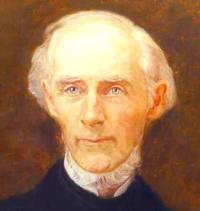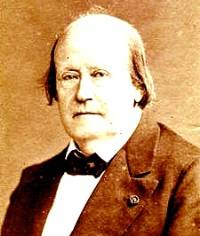On the Origins of New Forms of Life
8.4: The Concept of Radiation
EUGENE M. MCCARTHY, PHD GENETICS
|
|
(Continued from the previous page)
 |
| Charles Darwin |
Neo-Darwinian theory requires that descriptions of evolution be in terms of trees of descent, with limbs strictly diverging. Such explanations of evolution in terms of divergence are certainly nothing new. They long predate Darwin, as he himself was well aware. In the Origin Darwin quotes Constantine Samuel Rafinesque (New Flora of North America, 1836: 6) as saying that "all species might have been varieties once, and many varieties are gradually becoming species by assuming constant and peculiar characters." In 1796, Étienne Geoffroy Saint-Hilaire noted a "unity of plan" among related organisms that suggested common descent. Indeed, in The Critique of Judgment (1790), even Immanuel Kant expresses the idea:

|
|
Rafinesque |

|
|
Saint-Hilaire |

|
| Kant |
 Buffon
Buffon
By 1766, Buffon was convinced new forms could arise by divergence from a common ancestor. The idea can be traced back at least as far as the German philosopher Gottfried Leibnitz (1646–1716), who thought the various types of cats might be descended from a common ancestor.
Radiation. Large groups of related forms are often described as arising via a process of divergent specialization called radiation, in which a single, ancestral form gives rise to numerous descendant "specialized" types. Thinking in terms of radiation gives rise to a particular way of talking about the evolutionary process. The ancestral form that founds a radiation is typically described as "small, primitive, and generalized" and, often (when terrestrial animals are in question) as an "insectivore." The various forms of life descended from it are "adapted" to particular "niches." In other words, they are supposed to be "specialized" for a particular way of life. They may be large carnivores, flying frugivores, small herbivores, or marine creatures living on plankton. In speaking of this process, evolutionary biologists talk of "lineages radiating into adaptive niches" or "post-extinction divergence." Always it is supposed that a radiation begins after a mass extinction has eliminated most of the forms that came into being during the previous radiation. Always, a "primitive, small, generalized" type initiates the new radiation. The various forms produced by any given radiation are always "more progressive" than those produced by the preceding one. At the end of a radiation, all the various specialized types it produces are wiped out again. All that remains is a "small, primitive, generalized" type (which founds a new radiation) and a few other types (whose descendants eventually go extinct). This viewpoint is the standard line expressed in educational texts introducing students to geology, paleontology, and evolutionary biology. For instance, Kemp (1982: 321) lists features of a typical adaptive radiation:
In portraying the geneses of groups of related forms, biologists tell the same sort of story again and again. Such accounts are widespread because, for many biologists, the very word related means "descended from a single common ancestor" (here single should be emphasized). Key words such as generalized and non-specialized reflect the theoretical assumption that evolution is a matter of refining a general category into a variety of advanced forms suited to "specialized niches."
Living in the Industrial Age, when specialization of labor was seen as the key to efficient production, Darwin seized on the factory metaphor and asserted that any generalized form (i.e., one that lacked a specialty) would be outcompeted and driven to extinction by specialized ones:
Thus, evolution, as conceived by Darwin, moves from the generalized type to the specialized type. Darwin made the world a workhouse. Progress and efficiency are important themes running throughout the Darwinian paradigm. It is for this reason that modern biologists use the adjective primitive rather than old in referring to early fossil forms; primitive suggests a sense of progress, when used in conjunction with words like modern or advanced, that the words old and young do not. Insectivorous diet and small size are commonly presumed because such traits are traditionally considered "non-specialized" and "primitive." But it is hard to see why. A small insectivore seems about as well suited to insect prey as is a lion to the consumption of larger victims.
In the early nineteenth century naturalists were fascinated with embryology. They saw a parallel between the course of embryonic development and the supposed progression from simple, "lower" forms of life to more complex, "higher" ones (i.e., invertebrate, to fish, to reptile, to mammal, and finally to human). Thus, in his best-selling book, Vestiges of the Natural History of Creation (1844), Robert Chambers based his rather peculiar account of evolution on this "law" of parallelism. As Bowler puts it, Chambers claimed that

|
| Karl Ernst von Baer |
This so-called law of parallelism was, at least initially, a linear concept in which each form of life could be ranked along a single line of progress. But the idea of a divergence from a "generalized" common ancestor gained support from studies of embryological development. In his Über Entwicklungsgeschichte der Thiere (1828), the German embryologist Karl Ernst von Baer (1792–1876) asserted there is no real resemblance, at any stage in its development, between the embryo of an organism in a "higher" category (e.g., Mammalia) and adult forms in "lower" categories (e.g., Pisces or Reptilia). Rejecting the notion that development was a matter of a straightforward climb up the scala naturae, he maintained that the development of an embryo into a mature organism is a process of specialization. Because the early embryo generally looks the same, even in the case of very distinct types of organisms (e.g., bird and mammal), he said it was "generalized." According to von Baer, from this generalized embryo, various, branching developmental pathways led to various types of mature organisms, each with its own particular specialty. The process of development became a matter of acquiring organs having specialized functions.

|
| Richard Owen |
Archetypes. Von Baer's ideas were influential and had effects even outside the field of embryology. In particular, the most prominent British paleontologist of Darwin's day, Richard Owen, thought von Baer's picture of branching specialization could be adapted to the fossil record. He attempted to show that the earliest members of a given taxonomic group to appear in the record lack specialized traits. The subsequent history of a group, Owen said, was an outward radiation of various lines leading to distinct specialties. Thus, according to Desmond and Moore (1991: 433),
But the meaning of "general" in the context of fossils cannot be the same as in the context of embryology. The fossil organisms to which Owen referred were mature organisms. So it would make no sense to say that an early mammal fossil was identical to that of an early bird (in the same way that a mammalian embryo is indistinguishable, at an early stage, from that of a bird). In general, early embryos are much the same in different vertebrate classes. But mature organisms most definitely are not. Thus, in the fossil context, Owen seems to have converted the meaning of the word general from "common to a variety of categories" to "lacking specialized traits."
Despite this seeming fallacy, Darwin incorporated into his theory of natural selection the idea of a generalized type gradually evolving into a variety of specialized types. In a letter to Huxley dated April 23, 1854, he wrote that

|
| Henri Milne-Edwards |
In the Origin, he refers to Owen's "most interesting work" On the Nature of Limbs (1849), in which Owen adapts von Baer's ideas to fossils. Darwin was also familiar with Milne-Edwards' claim that specialized organs make for a more efficient organism (Milne-Edwards compared specialized organs with specialized workers on an assembly line). In particular, Darwin seems to have been convinced by his friend William Carpenter that evolution is a matter of continuous change from the generalized to the specialized (Boorstin 1983: 321, 394).
Along with many other naturalists in the mid-1800s, Darwin believed all organisms in a category were constructed according to a basic plan, an "archetype," that epitomized the category. Although most naturalists saw archetypes as ideal or abstract forms, models on which all organisms of a given group (e.g., vertebrates) are constructed, Darwin saw more. As he himself noted in the margin of Owen's book (On the Nature of Limbs):
In Darwin's mind, the archetype, an abstract form, became a living, breathing ancestor. He visualized an ancient, generalized progenitor giving rise, by means of gradual radiation, to a plethora of specialized descendants. Thus, in the Origin, he claims that, in the gradual adaptation of limbs to various functions (e.g., burrowing, swimming, flying),
Note that even Darwin admits (italics) that the limbs of this "ancient progenitor" must have served some purpose (walking? pouncing? climbing?). Therefore, even if one chose to suppose evolution did proceed in a strictly divergent, treelike fashion, there would be no reason to believe that the progenitor (from which the others are descended with modification) was unspecialized. Why, then, should we suppose it was a "generalized" archetype? Surely, it would have had its own way of living and, thus, would have been specialized in its own way.

|
| Ford Assembly Line, 1913 |
The idea of specialization in evolution is strangely attractive, but it really doesn't make sense. The analogy doesn't work. In the world of economics, specialization confers an advantage in accomplishing some overall task. Specialized workers band together to assemble a car or construct a house and so obtain an advantage over any individual who would attempt to do the same on her own. Here, a complex task is carried out more efficiently with specialized workers. The same analogy holds, as Milne-Edwards points out, with respect to the various specialized organs that make up a living being. There, the various specialized organs perform together the overall task of maintaining the organism in existence. But even if we grant that some types of organisms specialize and that some do not, it is still clear that distinct specialized forms do not cooperate like factory workers to accomplish a common goal. From the standpoint of the factory metaphor, each form of life is an individual. If there is no overall task, then there is no particular advantage in specialization. It therefore seems that Darwin based an important claim of his theory on an inappropriate analogy.
Conclusion. Since even bacteria are known to engage in a form of hybridization (see Section 8.3), we may reasonably suppose new forms of life were arising by stabilization processes, even in times as old as the earliest strata in the fossil record. There therefore seems to be no need to posit gradual divergence in isolation, even at the very earliest stage of evolution on earth. The processes posited by stabilization theory appear to be sufficient to explain everything we know from fossils about evolution.
Indeed, we have no clear evidence that the various higher taxonomic categories are "natural" (i.e., that they can and should be delineated in terms of descent from a single common ancestor). Biologists have long disputed the correctness of their phylogenetic trees and the allotment of organisms into taxonomic categories (see discussion in Section 5), in what Thompson (1992: 3) called the "endless search after the blood-relationships of things living and the pedigrees of things dead and gone." There is certainly no reason to take such quarrels as evidence that the history of evolution has been treelike in form. In fact, the very existence and prevalence of such disputes constitutes evidence to the contrary. Still less can we assume diverse arrays of related forms arise via a process of "radiation" — an idea based on a flawed analogy. It appears biologists have needlessly attempted to force all of the various forms of life on Earth into a tidy, strictly branching, artificial system of classification that fails to reflect the true nature of their origins. In point of fact, all that we truly know (as we have seen) is that this poorly substantiated hierarchal topology originated in the arcane metaphysical dogmas of the scholastics. Given the facts thus far presented it seems far more plausible to suppose a different topology applies. We can picture similarity sets evolving over time into new similarity sets, networks replacing networks. Stabilization processes can be envisioned as starting with a few simple organisms during the first stages of life on earth and then, with time, producing a wide array of complex forms.